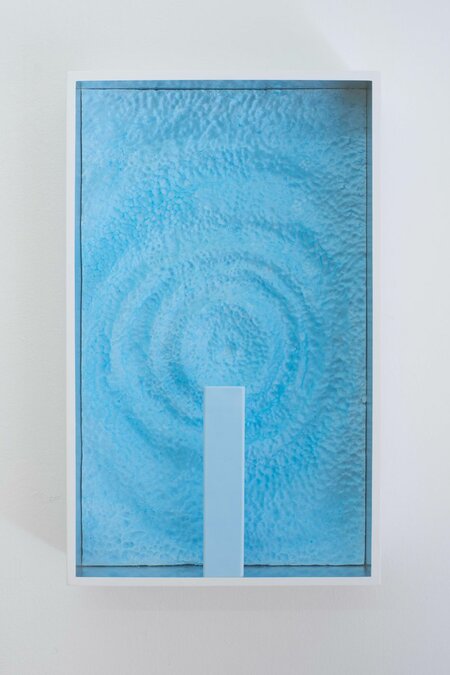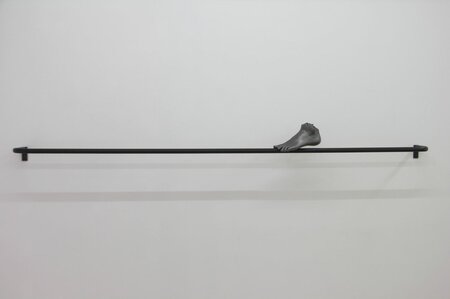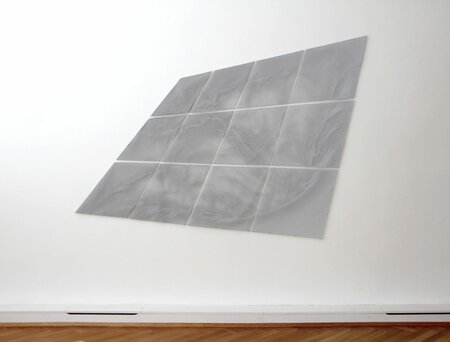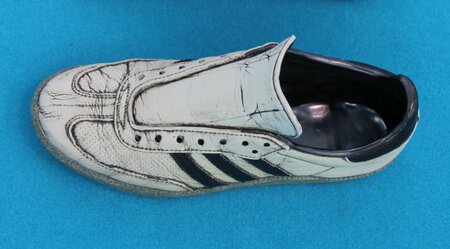Exhibition
A Constant State of Levitation
08.06. - 31.08.2018
Text by Till Julian Huss
Levitation is a technical process in which an object is made to float freely. Conceptually, the state of limbo can be understood as a departure from a solid ground, a final basis from which knowledge can be clearly derived. Miriam Jonas and Lena von Goedeke create this levitation of objects by using their material in an unconventional way or by ascribing new meaning to its function. Meaning does not arise from a knowledge of the things and their purpose, but from an aesthetic experience that also includes the embedding of the works in their presentation context. The indifference of the levitation stands as a strategy for a fundamental moment of artistic activity: In dealing with the materiality and function of the objects, the factual is opened up to the possible. Both artists exploit this potential in different ways: Jonas as the other, the uncanny and the posthuman, von Goedeke as his own, the technical and the post-digital.
By reinterpreting the space, the artists create their own coding with which they connect the individual works with one another. A central value in this coding is the pool. Through the placement, materiality, feel and color of the objects, they encircle the topic with aspects of the liquid, the structure of the water surface, the safety railing, the springboard and the soap aroma without clearly naming them. From the special architecture of the gallery, the height differences of the individual rooms and the small connecting stairs, they derive the pool as a conceptual starting point in order to tie in their own position. In this way, they combine existing works with new works created especially for the exhibition.
The work Fokus (2014) by Miriam Jonas is a mural composed of tiles and joints. By darkening the joints in the center, she emphasizes the grid structure and gives the picture a narrative moment, because normally the joints only get darker through use and soiling. In the Pool series (2018), Jonas processed XP foam panels in such a way that a structure similar to a water surface is created, which also corresponds to the top view of a pool due to its shape and surround. Distributed across the exhibition rooms, she presents a towel and socks (Socks, 2018), at the ends of which glowing, sometimes intensely colored crystals have formed. It seems as if the textiles have gotten wet and have formed crystalline structures as a result of a chemical reaction. With Boss (2016) she transfers the red shell of a crab into the cool, shiny black surface aesthetics of her formal language. The slightly rotating eyes are reminiscent of the movement of inanimate matter in the history of automatons and puppets and create an uncanny presence of another, of a life of its own for things. The smoothed or sparkling surfaces hide the strange and gruesome quality of an underlying narrative or vitality.
Lena von Goedeke has one foot balanced on a railing on the wall. With its soap scent and its unusual materiality and lightness, the work Firm refers directly to both the pool setting of the exhibition space and the state of suspension in the exhibition title. On the floor in front of the pole, a new carpet has been laid into which she has cut structures. On the fabric is the work Bittersweet, ceramic shoes as a cast of the Adidas Samba model, which was particularly popular in her youth and student days. With the geometric patterns and the personal references, she combines two aspects that are essential for her artistic work: the own as the structure of memory and the private environment and the technical as the structure of a digital and industrial milieu. As a post-digital strategy, Von Goedeke translates technical practices and the associated scientific knowledge systems into more traditional media and thus specifically into the material. What is one's own serves as a personal appropriation, as a structure imposed from within in relation to the technical structures that meet it.
Both artists turn to an analysis of the material, the starting point of which is a productive suspension of the ascription of function and meaning. The resulting new structures and surfaces also require the viewer to be located in the room by deliberately playing with perspective and distance performance, as in the series Pool by Miriam Jonas or the work Radar II by Lena von Goedeke. In addition to these structures emerging on the surfaces, the artists are also interested in those invisible elements that can be derived from the processing and use of the material rather than a semantic of form.
The works that are in suspension do not require a completely different perspective that lies beyond the conscious or the human. Rather, they address an individual perception and experiential and emotional localization that, after the crisis of the subject in the 20th century, assures itself of its own position and role in the current technical reality. The pool as an associative chain can also be understood as a metaphor for our currently fluid postmodernism: traditional foundations are exposed and questioned. A constant levitation sets in. In this state, Jonas and von Goedeke use the special examination of materiality to make sure of things. Our world of experience is a milieu composed of nature, culture, the animate, the inanimate and the technical, whose peculiarities we hide in the fixed routine of our everyday life. Freed from conventional ascriptions, things come towards us as something else than something also uncanny (Jonas) that the fringes of ours are used to
Shows the world of experience, or as something technical (von Goedeke) that pushes the boundaries of human-made visual worlds. The subject returns under the conditions of the returnee.
Levitation is a technical process in which an object is made to float freely. Conceptually, the state of limbo can be understood as a departure from a solid ground, a final basis from which knowledge can be clearly derived. Miriam Jonas and Lena von Goedeke create this levitation of objects by using their material in an unconventional way or by ascribing new meaning to its function. Meaning does not arise from a knowledge of the things and their purpose, but from an aesthetic experience that also includes the embedding of the works in their presentation context. The indifference of the levitation stands as a strategy for a fundamental moment of artistic activity: In dealing with the materiality and function of the objects, the factual is opened up to the possible. Both artists exploit this potential in different ways: Jonas as the other, the uncanny and the posthuman, von Goedeke as his own, the technical and the post-digital.
By reinterpreting the space, the artists create their own coding with which they connect the individual works with one another. A central value in this coding is the pool. Through the placement, materiality, feel and color of the objects, they encircle the topic with aspects of the liquid, the structure of the water surface, the safety railing, the springboard and the soap aroma without clearly naming them. From the special architecture of the gallery, the height differences of the individual rooms and the small connecting stairs, they derive the pool as a conceptual starting point in order to tie in their own position. In this way, they combine existing works with new works created especially for the exhibition.
The work Fokus (2014) by Miriam Jonas is a mural composed of tiles and joints. By darkening the joints in the center, she emphasizes the grid structure and gives the picture a narrative moment, because normally the joints only get darker through use and soiling. In the Pool series (2018), Jonas processed XP foam panels in such a way that a structure similar to a water surface is created, which also corresponds to the top view of a pool due to its shape and surround. Distributed across the exhibition rooms, she presents a towel and socks (Socks, 2018), at the ends of which glowing, sometimes intensely colored crystals have formed. It seems as if the textiles have gotten wet and have formed crystalline structures as a result of a chemical reaction. With Boss (2016) she transfers the red shell of a crab into the cool, shiny black surface aesthetics of her formal language. The slightly rotating eyes are reminiscent of the movement of inanimate matter in the history of automatons and puppets and create an uncanny presence of another, of a life of its own for things. The smoothed or sparkling surfaces hide the strange and gruesome quality of an underlying narrative or vitality.
Lena von Goedeke has one foot balanced on a railing on the wall. With its soap scent and its unusual materiality and lightness, the work Firm refers directly to both the pool setting of the exhibition space and the state of suspension in the exhibition title. On the floor in front of the pole, a new carpet has been laid into which she has cut structures. On the fabric is the work Bittersweet, ceramic shoes as a cast of the Adidas Samba model, which was particularly popular in her youth and student days. With the geometric patterns and the personal references, she combines two aspects that are essential for her artistic work: the own as the structure of memory and the private environment and the technical as the structure of a digital and industrial milieu. As a post-digital strategy, Von Goedeke translates technical practices and the associated scientific knowledge systems into more traditional media and thus specifically into the material. What is one's own serves as a personal appropriation, as a structure imposed from within in relation to the technical structures that meet it.
Both artists turn to an analysis of the material, the starting point of which is a productive suspension of the ascription of function and meaning. The resulting new structures and surfaces also require the viewer to be located in the room by deliberately playing with perspective and distance performance, as in the series Pool by Miriam Jonas or the work Radar II by Lena von Goedeke. In addition to these structures emerging on the surfaces, the artists are also interested in those invisible elements that can be derived from the processing and use of the material rather than a semantic of form.
The works that are in suspension do not require a completely different perspective that lies beyond the conscious or the human. Rather, they address an individual perception and experiential and emotional localization that, after the crisis of the subject in the 20th century, assures itself of its own position and role in the current technical reality. The pool as an associative chain can also be understood as a metaphor for our currently fluid postmodernism: traditional foundations are exposed and questioned. A constant levitation sets in. In this state, Jonas and von Goedeke use the special examination of materiality to make sure of things. Our world of experience is a milieu composed of nature, culture, the animate, the inanimate and the technical, whose peculiarities we hide in the fixed routine of our everyday life. Freed from conventional ascriptions, things come towards us as something else than something also uncanny (Jonas) that the fringes of ours are used to
Shows the world of experience, or as something technical (von Goedeke) that pushes the boundaries of human-made visual worlds. The subject returns under the conditions of the returnee.
Exhibited works

Miriam Jonas

Miriam Jonas

Miriam Jonas

Miriam Jonas

Miriam Jonas

Miriam Jonas

Miriam Jonas

Miriam Jonas

Miriam Jonas

Miriam Jonas

Lena von Goedeke

Lena von Goedeke

Lena von Goedeke

Lena von Goedeke

Lena von Goedeke

Lena von Goedeke

Lena von Goedeke

Lena von Goedeke

Lena von Goedeke

Lena von Goedeke

Lena von Goedeke





